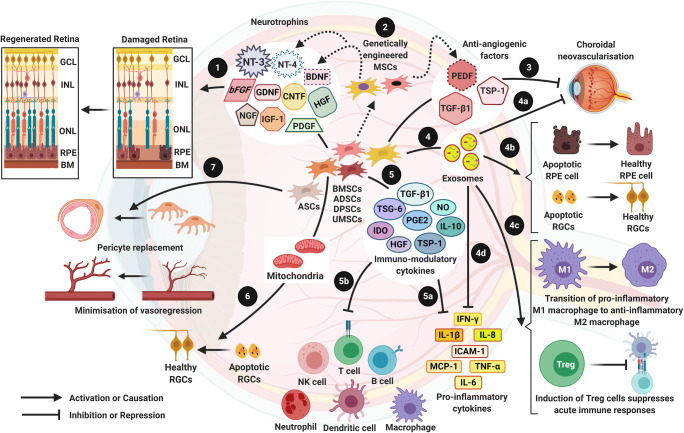Fig. 1.
Mesenchymal stem cells for treatment of retinal degenerative disorders 1) MSCs have the ability to secrete several neurotrophins which play a cytoprotective role in degenerated retina, found in multiple retinal diseases such as AMD, SD, DR, RP, and Glaucoma [63]. 2) MSCs can be genetically engineered to express neurotrophins such as NT-4 [168], BDNF [167] and anti-angiogenic factor PEDF [124] that can improve therapy outcome. 3) AMD and DR are associated with pathological angiogenesis which leads to abnormal growth of blood vessels (Choroidal neovascularisation) and haemorrhages within the ocular microenvironment [43, 198]. Anti-angiogenic factors released by MSCs can reverse abnormal pathological angiogenesis [77, 115]. 4) MSCs secrete exosomes, microvesicles which contain a cargo of biomolecules such as mRNA, lipids, several proteins with therapeutic advantages: (4a) Exosomes contain anti-angiogenic factors [87] that can inhibit pathological angiogenesis; (4b) mRNA molecules in the exosomes provide neuroprotection of essential retinal cells [88]; (4c) molecules within the exosomes prevent the activation of macrophages and induce Treg cells, hence downregulating disease causing immune responses within the ocular tissue [104]; and (4d) anti-inflammatory factors in the exosomes [86] aid in the recovery of retinal degeneration in AMD, DR and Glaucoma. 5) MSCs secrete immunomodulatory cytokines [102], which (5a) represses the action of pro-inflammatory cytokines and (5b) thwart acute immune responses, both of which are involved in the pathogenesis of AMD, DR and Glaucoma. 6) MSCs provide cytoprotection by donating healthy mitochondria to apoptotic retinal cells through formation of cell-cell contact via tunneling nanotubes or gap junctions [140]. 7) ADSCs can replace pericytes and stabilize vasculature in DR [151].

